
Please be aware that some specialist imagery may take time to load.
This site is designed for dedicated researchers on desktop or tablet, not ideal for mobile browsing.
We start here with the earliest model - the slide or "pump-action" rifle.

The B.S.A. slide action rifle was the British equivalent of the Winchester, Remington and Fabrique Nationale - (FN) Browning pump-action repeating rifles. It was manufactured mainly with the tube magazine as shown in the advertisement below, but early in production, from 1923, a small number (probably a maximum in the very low hundreds*) of these rifles were produced with a box magazine. This version was then little advertised and is rarely come across today. The action is simply marked "Patent Pending" .

A pretty and well balanced design, the operating system was not as reliable as its well-proven American counterparts and sales probably suffered as a result, although prices in the U.K. were fairly well in its favour by comparison with the Remington and Winchester slide or "pump" action rifles, all being only a few shillings either side of £5.00 in 1925. The then newly introduced Browning pump-action rifle was entirely a different matter. This hit the market running at the incredibly competitive price of only three pounds and five shillings (£3.25).
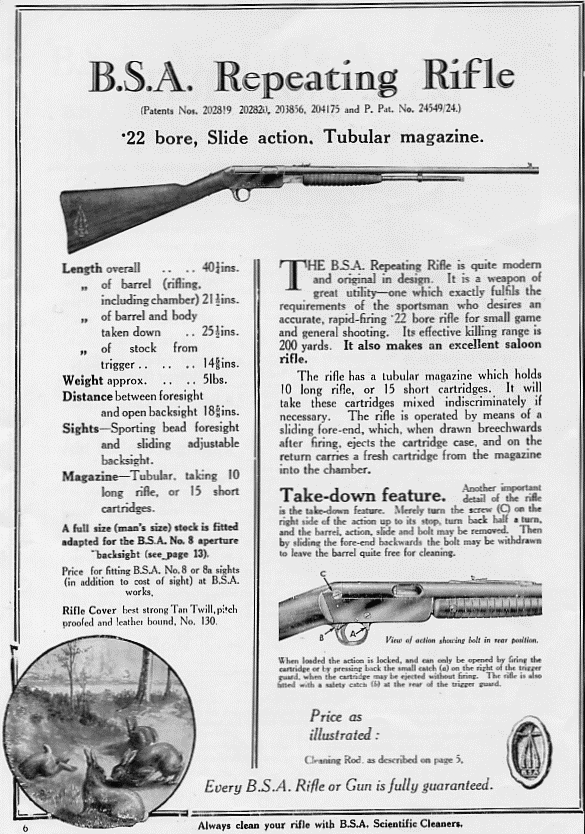
John Knibbs, in his book "BSA - The Golden Century", writes that the first of these rifles was serial numbered 252, and that only the first two hundred were of the magazine-fed version before the tube magazine was introduced just one year later.
However, we had noted that a number of these rifles are serialled in the 1*** range; with our own two archived examples being respectively 1032 and 1077.
The former of these has the "1"stamped with a different set of tools from the following "032". We are aware that this occurred with the earlier examples of other models of BSA production, and it has been rather assumed that batches of one thousand components were pre-stamped with the 'thousand' number, the remaining three serial number digits being added on final assembly. This would have precluded any confusion that could occur with the removal of any production that failed inspection.
Notwithstanding, we have been shown an auction catalogue lot entry for a box-magazine version, from about forty years ago, reporting a serial number of 521. Having often used that now defunct auction house in the past, we suspected an error, as we knew only too well that their catalogues carried a considerable number of typographical errors. Obviously, if it was correct, the entry would markedly add to the uncertainty of the production numbering of these rifles. This now appears to be the case, as an Australia-based colleague has pointed out a photograph on the 'Milsurps' forum confirming that another box-magazine-fed rifle is stamped with serial number 825.
The lowest of which we have become aware is s/no. 288.
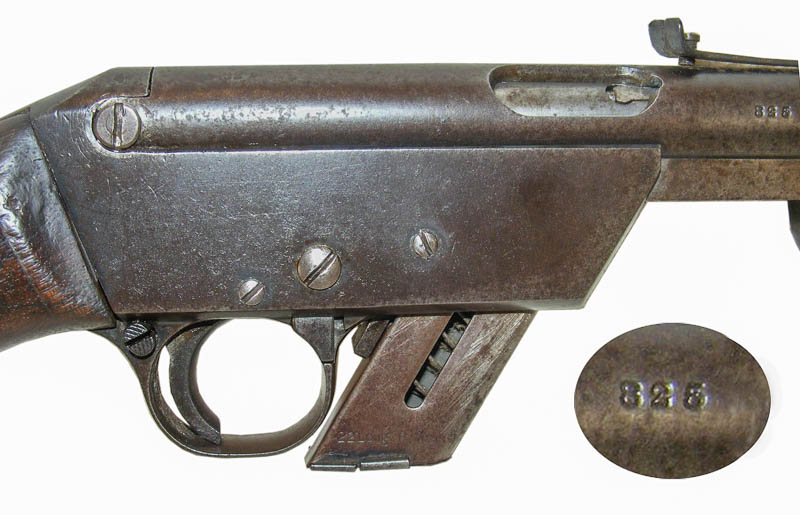
As John Knibbs holds the original BSA production records, it seemed likely that his understanding of a production number of only 200 was the definitive answer. Rifles that we had seen until recently led us to suspect that these left the factory having been serialled from 1,000, as none exceeded 1200. This did not explain the stated 252 starting number, but a typo or other recording error was suspected. With due deference to John Knibbs, who is immensely experienced and has always been thoroughly particular in his reporting of BSA matters, it now appears his assessment of this particular matter may have been mistaken.
If you know of rifles' serial numbers that would add to the available data,
do please let us know (with photographs of course).
The magazine of rifle s/n 1022 in situ

and shown separately, loaded with six rounds
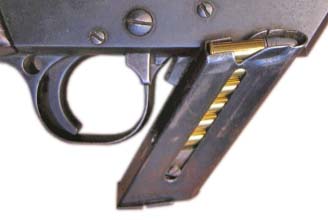
The rifle "taken-down"
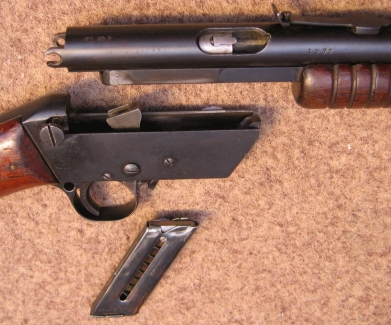
The barrel markings and rear-sight ....

The markings are similar to those of the War Office Pattern Miniature Rifle, i.e.,
Made By
The Birmingham Small Arms Co. Ltd.
England
Cartridge .220 Long Rifle
We have been fortunate enough to obtain the original 1923
patent application by B.S.A. Guns Ltd
for this box magazine action.
Click on the drawing for the complete specification.
See also the comparable Savage Arms design of 1903
The following year saw the introduction of the Tubular Magazine Model, of which around 8,000 were manufactured before the commencement of the Second World War* brought such production to an abrupt close. The manufacture of this design was destined not to be reinstated post-war, effectively leaving the market for slide-action rifles clear for Winchester and FN (Browning).

The rifle above has been professionally fitted with a sophisticated pair of quick release offset claw mounts for a German manufactured "Gnomet" telescopic sight (not illustrated), and the muzzle has been threaded for a sound moderator - the knurled cap at the muzzle being the screw-on thread protector for when the silencing system is not in use.
Below: as advertised in 1925 as a "Take-down" rifle

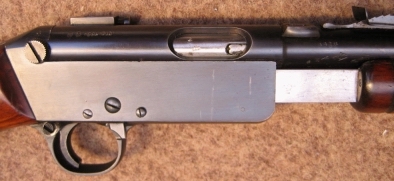
Below: the patent no. of the main production version with the tubular magazine
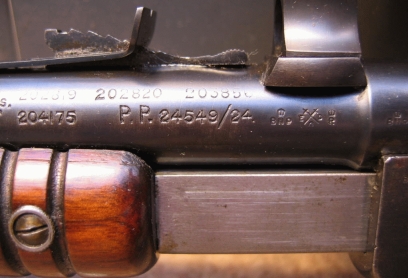
Click the patent drawing below to view the complete patent
Below: the tube-magazined rifle shown taken down,
We have not seen one of these in the flesh, but there was an example of a tubular-fed rifle
with the action finely engraved with a sporting scene, with chequered wrist and fore-end grip,
the latter being of a diameter significantly enlarged from the standard product;
the rifle was described as a BSA special De-luxe version,
such as was available with their contemporary models of Martini small-bore rifles,
and even the War Office Pattern Miniature Rifle.

With thanks to John Knibbs

See: BSA "The Golden Century" pgs.62-63
Of these factory custom-built rifles, another unusual example, serial no. 3555,
has come to light with a finely chequered pistol-grip stock,
the chequering being otherwise of the same format as the de-luxe model.
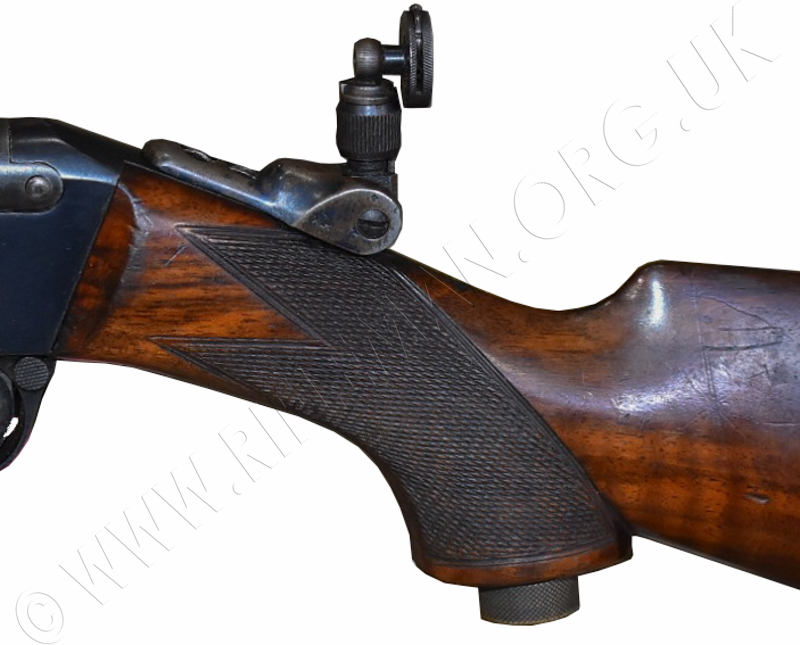
With thanks to GeneB
The rifle has been fitted with a Parker-Hale Sportarget fold-back aperture rear-sight,
which was their model 10.B.S. specifically made for the BSA 'repeating rifle' of the day.
This early Sportarget sight was introduced ca. 1933, and was also available
for the various equivalent imported models of Winchester, Browning, Remington and Savage rifles.
The sight was still advertised post-war in their 1946 catalogue.
For those interested in the rifling of the BSA pump-action models,
here is an image of the whole bore length derived from the stacking of a series of 44 images.
Viewed from the muzzle.
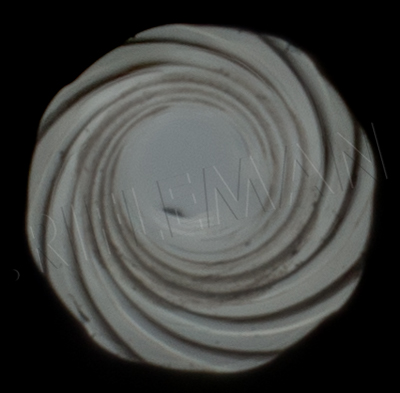
It will be seen to be 8-groove, right-hand twist, with lands little wider than the grooves.
It is interesting to compare this with the wide-groove/narrow-land of the very accurate rifling of the earlier Model 12 target rifle,
of which a BSA drawing is shown about half way down that page.
* John Knibbs -"BSA - the Golden Century" - see Recommended Reading
Return to: TOP of PAGE
See this website's Raison d'être